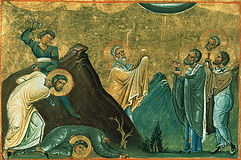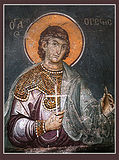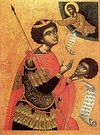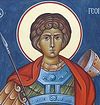 Apostles of the Seventy Erastus, Olympas, Herodion, Sosipater, Quartus, and Tertius (Terence) (1st c.).
Apostles of the Seventy Erastus, Olympas, Herodion, Sosipater, Quartus, and Tertius (Terence) (1st c.).
Commemoration of the beginning of the torture of Great-martyr George (303). Martyr Orestes the Physician, of Cappadocia (304). Hieromartyr Milos (Miles), bishop in Persia, and his disciples, Martyrs Aborsam and Senoe (ca. 341). Great-martyr Constantine-Kakhi, prince of Kartli, Georgia (852). St. Theocteristus, abbot, of Symbola Monastery on Mt. Olympus in Bithynia. Glorification of St. Matthew, monk, of Yaransk (1997).
New Hieromartyrs Procopius (Titov), archbishop of Kherson, and Seraphim (Gushchin), hieromonk of Optina Monastery (1931). New Hieromartyrs Augustine (Belyaev), archbishop of Kaluga, and with him Ioannicius (Dmitriev), archimandrite, of the St. George Monastery (Meshchevsk), Niphon (Vyblov), hieromonk, of Berezovy Khutor (Saratov), and John Speransky, archpriest, of Kaluga (1937). New Martyrs Alexis Gorbachev, Apollonius Babichev. and Michael Arefeyev, Nicholas Smirnov, Anna Ostroglazova (1937-1939). New Martyrs Olga Maslennikova (1941) and Theoctista Chentsova (1942).
St. Eucharius, first bishop of Trier (3rd c.). St. Nonnus, bishop of Heliopolis (471). St. Justus, archbishop of Canterbury (627- 631). Ten Martyrs of Gaza, at Jerusalem: Callinius, Imerius, Diasimus, Theodore, Stephen, Peter, Paul, Theodore, John, and John (638). Translation of the relics of St. Gregory, bishop of Assos near Ephesus (1150).
Wednesday. [II Thess. 2:1-12; Luke 12:48-59]
Suppose ye that I am come to give
peace on earth? I tell you, Nay; but rather division: For
from henceforth there shall be five in one house divided,
three against two, and two against three. The father shall
be divided against the son, and the son against the
father; the mother against the daughter, and the daughter
against the mother; the mother-in-law against her
daughter-in-law, and the daughter-in-law against her
mother-in-law. What is the reason? Those who believe
in the Lord are filled with an entirely different spirit,
contrary to that which reigned in people before His
coming; that is why they cannot get along together. The
pagan world pursued exclusively worldly and earthly
interests. The Jews at least had indications of higher
good things, but towards the end they inclined toward the
path of the pagans. The Lord, coming to the world, showed
people other treasures, outside of the family, outside of
society, and awakened other aspirations. Those who
accepted His teaching naturally established a way of life
different from before, for which they were subjected to
hostility, oppression, and persecutions. This is the
division. The Apostle Paul then said that all desiring to
live godly in Christ Jesus shall suffer persecution
(II Tim. 3–12). So it was and so it is. When worldly
and earthly interests begin to prevail in society, then
society looks unfavourably at those who display other,
unearthly strivings; it cannot even understand how it is
possible to be interested in such things. People cannot
stand those who serve as representatives of a way of life
which is not similar to their life. This is happening now
before everyone’s eyes. Is this not a sign of the
times?…


![]() Apostles of the Seventy Erastus, Olympas, Herodion, Sosipater, Quartus, and Tertius (Terence) (1st c.).
Apostles of the Seventy Erastus, Olympas, Herodion, Sosipater, Quartus, and Tertius (Terence) (1st c.). 

















